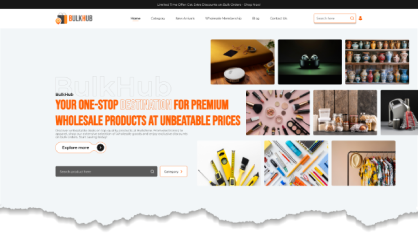
Efficiency and accuracy stands above all when operating an effective e-commerce business. You may have felt that it drove you crazy with the number of calculations you had to make while managing financial data and dealing with accounts for a WooCommerce store owner, even more so when toggling between multiple platforms. Since everyone lives online today, why struggle with bookkeeping and maintaining your accounts and documents in hard copy? WooCommerce can be integrated with QuickBooks to make your business processing easier. If any of the technical stuff sounded foreign to you, consider these your guide. Whether you're finally taking automation to bookkeeping for granted to save time in manual data entry, or realizing the potential to glean serious insights into financial health, our practical tips and insights will give you a seamless and effective Woocommerce Quickbooks integration in no time.
What Are QuickBooks?

QuickBooks is an accounting and bookkeeping software package designed to help small and medium-sized businesses organize their finances. In simple words, the software allows users to track money coming in and going out and also keep track of all invoices, thus assuring that payroll is done right. Using QuickBooks, you can generate any possible financial report so you'll always see how your business is doing. You're able to track sales and expenses and get organized for tax time. You can use it on your computer as an installed software or online from any web browser, so the access to your financial information is pretty easy from anywhere. In other words, QuickBooks simplifies bookkeeping so you can run your business.
To create a professional website that complements your use of QuickBooks, consider using a premium WordPress themes. Our themes offer advanced customization options, sleek designs, and seamless integration with business tools, ensuring your online presence is as polished and efficient as your financial management.
The Need For QuickBooks
Every business uses tools like Woocommerce Quickbooks for a number of reasons, all of which revolve around the smoothing out of the operation of finances, business management, and boosting of sales. Here is the list of all the reasons your business needs QuickBooks:
- QuickBooks maintains and keeps a record of all the organization's financial activities from income to expenditure and even payments. This accuracy provides you with a precise view of your financial health. This minimizes the risk of errors that can occur due to manual bookkeeping.
- This software is generally designed to help you create your own professional-looking invoices and easily send them to your clients. It also helps you understand paid-up invoices sent and those that are overdue, promoting better cash flow and reduced follow-ups.
- QuickBooks allows for easier management of payroll through automatic calculation of wages, taxes, and benefits for the employee. One is also able to create pay slips and process direct deposits. All this greatly saves time and minimizes the risk of payroll errors.
- It helps generate many financial reports, such as profit and loss statements, balance sheets, and cash flow statements. Such reports give insight into how your business is performing to enable one to make sound, very informed decisions.
- QuickBooks will keep all your financial records in one place. No hassle during tax season. It makes filing taxes easy and complying with the tax regulation easy.
- Organize your expenditure, track transactions, and handle accounts the structured way. This business organization tool helps to stay ahead of your finances and allows access to important information as per your need.
- The program automatizes several accounting-related tasks, such as invoicing, payrolls, and generation of financial reports. This will save you a lot of time and also reduce the need for manual data entry. All these factors reduce your overall accounting cost and save time for other crucial business activities.
- QuickBooks is scalable, and thus it grows with your business. Be it a small startup or an enterprise looking to expand, QuickBooks has got features and plans that will scale up as per your requirements.
- QuickBooks will further integrate with many other business tools and services, like payment processors, CRM systems, or e-commerce platforms. This gives a way for easy flow of data between different areas of your business.
- Even with all its powerful features, QuickBooks is designed to be user-friendly. This means that you do not need extensive accounting knowledge or experience to use it. The ease of use ensures that you can handle your finance efficiently without any kind of specialized training.
Benefits of Adding QuickBooks to Woocommerce
Adding Woocommerce Quickbooks offers many benefit, it would manage your accounting transaction in efficient way and beneficial in managing your online store. Let explore how it may benefit you on various parameters.
- Automated Financial Tracking: Financial Tracking imports sales, refund and expenses transactions from woocommerce into QuickBook , this ultimately reduces the manually data entry. It also keeps your financial data up to date, reflecting real time transactions.
- Improved Accuracy: There is always a risk of mistakes when we practice manual data entry but with the help of quickbook accuracy without any error is achieved while recording the transactions.
- Time saving: Automation features is effective time saver it synchronises sales data, invoices and payment details.
- Enhanced Financial Insights: Gain access to detailed financial reports and insights, such as profit and loss statements, balance sheets, and cash flow statements, which can help in making informed business decisions.
- Simplified Tax Preparation: Keeps records and data of sales tax collected and paid , this ensures easier tax filing and tax return.
- Better Inventory Management: tracking inventory is very important when have manage stock and over selling of the product, quickbooks help in managing inventory from time to time.
Different Types of QuickBooks Integrations
QuickBooks has many integration options to extend its abilities in running your business. The following are integrations of the different types in QuickBooks:
1. E-Commerce Integrations
- WooCommerce: Sync sales, inventory, and customers from your online store with QuickBooks.
- Shopify: Integrate your Shopify store with QuickBooks to automate how orders and payments are tracked and goods are inventoried.
- BigCommerce: Integrate your BigCommerce store seamlessly with QuickBooks to be able to manage your orders, customers, and financials with ease.
2. Payment Processing Integrations
- PayPal: connects PayPal transactions with QuickBooks to make reconciliations for the payments and fees received much easier.
- Square: Square transactions, sales information, and details of each payment are integrated into QuickBooks for ease of management.
- Stripe: Stripe's payment data is connected to QuickBooks for automatic logging of transactions and customer payments.
3. CRM Integrations:
- Salesforce: The customer information in QuickBooks is synced through this integration. It manages prospects, your sales pipeline within Salesforce, and automates your invoicing and financial reporting.
- HubSpot: Connect HubSpot to QuickBooks in order to synchronize marketing and sales data, customer engagement management, and tracking of financial performance.
4. Inventory Management Integrations
- TradeGecko: This integration synchronizes the levels of inventory, orders, and sales data from TradeGecko to QuickBooks, so one will be able to maintain finer control over one's inventory and finances.
- DEAR Inventory: Integration of inventory management with Woocommerce Quickbooks for the automation of order processing, tracking of inventory, management of purchases and sales, and other associated tasks.
5. Project Management Integrations
- Trello: Connects Trello to QuickBooks for tracking expenses related to projects more effectively, so one is able to manage their budgets for specific projects in a more efficient way.
- Asana: This integration provides integration with Asana to enable the tracking of project expenses against tasks and projects, while also ensuring that customers' invoices and financial reports are accurate.
6. Payroll Integrations
Gusto: Sync payroll data, employee information, and tax details to QuickBooks for easy processing and compliance with taxes.
ADP: Assimilates ADP payroll data with QuickBooks to facilitate the ease of managing payroll while also ensuring the integrity of the financial records.
7. Bank and Financial Integrations
- Bank Feeds: Bank transactions are automatically imported to QuickBooks for reconciliation and the tracing of finances.
- Credit Card Feeds: This integrates all credit card transactions to automate expense tracking and thus easily manage finances.
8. Accounting and Tax Integrations
- Tax Software: The integration of TurboTax or TaxAct software for tax preparation allows for easy filing and perfect financial reporting.
- Manage Expenses: Integrates with expense management tools such as Expensify or Receipt Bank to manage and track expenses more effectively.
9. Reporting and Analytics Integrations
- Fathom: Provides advanced financial reporting and analytics integration with QuickBooks for insights into the performance of a business.
- G-Accon: Integrates Woocommerce Quickbooks into Google Sheets for custom reporting and data analysis.
10. Custom Integrations
- API Integrations: Integrate QuickBooks with custom-made software applications to suit specific business needs using the QuickBooks API.
These integrations help automate workflows, improve accuracy, and provide valuable insights that will enhance your overall business operations.
Plugins for WooCommerce QuickBooks Integrations
This integration can increase financial management for you and smooth your business processes. The following are some of the premium WordPress plugin for WooCommerce to QuickBooks integrations.
1. QuickBooks Sync for WooCommerce

This plugin offers to synchronize orders, customers, and products from WooCommerce to QuickBooks Online, making all business management into one process. All your sales data and inventory updates are automated.
Features
- Orders and Invoices are synchronised automatically
- Synchronisation of Products and Inventory levels
- Multiple Currencies supported by the plug-in
2. Zapier for WooCommerce and QuickBooks

The WooCommerce to QuickBooks Zapier integration utilizes automated workflows, referred to as Zaps, created to allow customized automation between the two respective platforms.
Features:
- Automates the transfer of data between WooCommerce and QuickBooks
- Custom triggers and actions available
- Supports multiple integrations and custom integrations
3. WooCommerce QuickBooks Integration by MyWorks Software

This integration plugin brings the integration of WooCommerce to QuickBooks Online. It brings automation to the synchronization of Order and Customer Data between the two.
Features:
- Orders, Customers, and Products automatically synchronize
- Field level mapping of WooCommerce data to QuickBooks with advanced mapping
- Comprehensive logs along with error reporting
4. Webgility QuickBooks Online Integration for WooCommerce

This Webgility integration makes your Woocommerce Quickbooks Online very easy. In addition to this, various other features include order and inventory management, and accounting management.
Features:
- Synchronizes orders, inventory and customer data
- Reconciliation of sales and expenses can be done automatically
- Data synchronization can be customized using rules and settings
5. Growbots QuickBooks WooCommerce Integration

The Growbots integration plugin fuels the syncing of WooCommerce data with QuickBooks. Bring the sales and accounting systems together simply.
Features:
- Orders, products, and customers are automatically imported
- Sales data is synchronized in real time
- Integration that supports a variety of plans within QuickBooks Online
How to Connect WooCommerce QuickBooks?
The process integrates WooCommerce with QuickBooks at multiple levels to allow smooth operations and proper data synchronization. Here is a step-by-step guide to connect WooCommerce with QuickBooks:
1. Choosing an Appropriate Plugin for Integration
- Research Available Plugins: Look out for plugins that can integrate WooCommerce with QuickBooks.
- Choose: Use a plugin that best serves your purpose and works well with the versions of WooCommerce and QuickBooks that you use.
2. Installing the Plugin
- Log in to WordPress Admin: Visit your WordPress admin dashboard.
- Go to Plugins: On the top left, click on Plugins > Add New.
- Search: In the search bar, type the name of your selected QuickBooks integration plugin.
- Install: Click the Install Now button beside the plugin you selected.
- Activate: When the process is complete, click Activate to activate the plugin on your site.
3. Setting up the Plugin
- Access Plugin Settings: Go to the settings page of the Plugin usually found under WooCommerce or Settings in your WordPress dashboard. Connect to QuickBooks Follow in-app instructions to connect to your QuickBooks Account.
- This usually includes: Authorize the access Log in with your QuickBooks account and authorize this plugin to access your data. API Key/Token Put any API keys or tokens that will be required by the plugin.
4. Configure Settings for Data Synchronization
- Map Data Fields: Configure how WooCommerce data like orders, customers, and products should map to fields in QuickBooks. This might involve setting up mapping rules and preferences.
- Select Sync Frequency: Identify how often data should sync from WooCommerce to QuickBooks. Options include real-time sync and daily sync.
5. Test the Integration
- Run a Test Sync: Process a test synchronization to check that all data is transferring appropriately from Woocommerce Quickbooks.
- Check Data: Check whether Orders, Customer Details, and Products are successfully synced between WooCommerce and QuickBooks.
6. Fine Tune Settings
- Adjust Settings as Needed: In case of any mismatch in the result for test sync, fine-tune the settings. Update mappings, the frequency of sync, or any other preferences.
- Set up Notifications: If this option is available within the plugin, set up notifications to track the status and errors related to synchronization.
7. Monitor and Maintain
- Configuration Checks: Run a configuration check once in a while to ensure that the integration is fine and the data syncs seamlessly.
- Update: Keep updating the WooCommerce and QuickBooks plugins for maintaining compatibility and security.
8. Seek Support if Needed
- Consult Documentation: Refer to the plugin's documentation for detailed configuration instructions and troubleshooting tips.
- Contact Support: Contact the support team of the plugin in case you are facing any difficulties or need assistance in configuration.
This way, after following these steps, you will be able to integrate WooCommerce with QuickBooks and manage your financial books more efficiently, with better accuracy.
Conclusion
The integration of Woocommerce Quickbooks is going to significantly enhance the financial control of your business by way of automatic synchronization of data and reducing errors. By selecting the appropriate plugin and using a well-structured setup process, you will be able to effectively connect your store to your accounting system. These are major steps in choosing a compatible plugin, its installation and configuration, mapping data fields, and testing the integration for smooth running. It will keep you up to date with your financial records and let you deal with problems the moment they arise. With properly done integration, you will automate bookkeeping processes, reduce manual errors, and get deep insights into the performance of your business. This will save you not only time but also give you so much clarity regarding your financial health, which is really important for decision-making in support of the growth of your WooCommerce store.
To enhance your WooCommerce store's functionality and design, consider investing in a WP theme bundle. A theme bundle offers a variety of high-quality themes at a discounted price, giving you the flexibility to choose the perfect look and feel for your store. This investment not only enhances your website's aesthetics but also supports a smoother, more efficient workflow when paired with your integrated QuickBooks solution.









